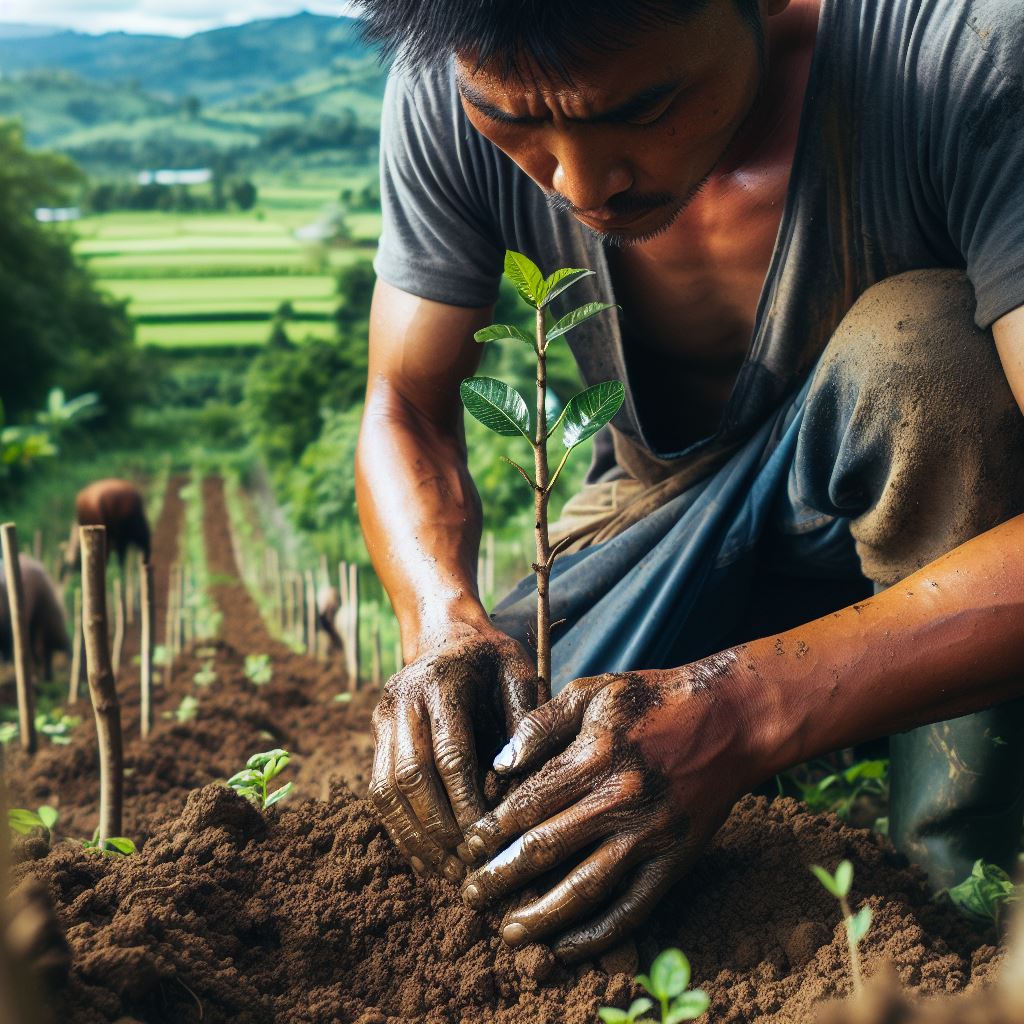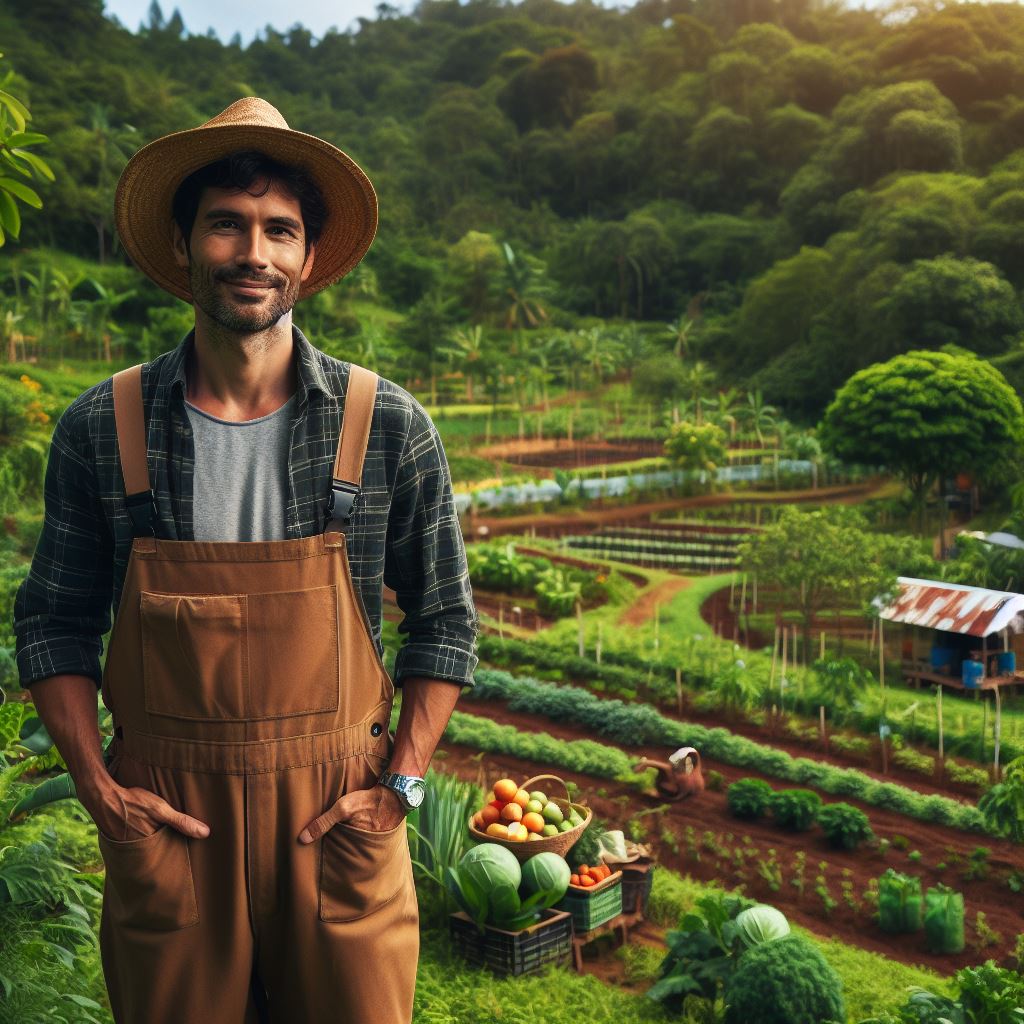Introduction
Agroforestry is the practice of combining trees, crops, and livestock on the same land to promote sustainability. Eco-friendly farming practices are crucial for preserving the environment and ensuring food security.
This blog post will discuss the benefits of agroforestry and how it can contribute to eco-friendly farming.
Agroforestry involves integrating trees and crops in the same agricultural system, offering a wide range of ecological and economic benefits.
By increasing biodiversity, it helps restore degraded land, improves soil fertility, and mitigates climate change.
This sustainable approach also provides shelter and food for wildlife, enhancing ecosystem services.
Eco-friendly farming practices such as agroforestry minimize the use of synthetic fertilizers, pesticides, and herbicides, reducing environmental pollution.
It promotes natural pest control, reduces erosion, and conserves water resources.
Moreover, agroforestry enhances soil health through the recycling of organic matter and the establishment of mutually beneficial relationships between plants and microorganisms.
In this blog post, we will delve deeper into the various agroforestry systems and their benefits.
We will explore how agroforestry contributes to carbon sequestration, mitigating greenhouse gas emissions.
Additionally, we will discuss examples of successful agroforestry projects from around the world, showcasing its potential to support sustainable livelihoods for farmers.
Stay tuned as we unravel the fascinating world of agroforestry and its invaluable role in eco-friendly farming practices.
Discover how this innovative approach can address environmental challenges while providing multiple benefits for farmers, communities, and the planet. Agroforestry truly is a path to a more sustainable and resilient future.
Benefits of Agroforestry
Agroforestry is a sustainable farming practice that combines trees and crops on the same piece of land.
By integrating agriculture and forestry, agroforestry provides numerous benefits for the environment, farmers, and society as a whole.
Transform Your Agribusiness
Unlock your farm's potential with expert advice tailored to your needs. Get actionable steps that drive real results.
Get StartedImproved soil health and fertility
One of the major advantages of agroforestry is its positive impact on soil health and fertility.
The presence of trees helps prevent soil erosion by acting as windbreaks and reducing water runoff.
Furthermore, tree roots help improve soil structure, increase organic matter content, and enhance nutrient cycling.
These factors contribute to long-term soil fertility, enabling farmers to sustain higher crop yields without excessive use of chemical fertilizers.
Increased biodiversity and habitat conservation
Agroforestry systems promote biodiversity by providing varied habitats for a wide range of plant and animal species.
Trees serve as valuable shelter and food sources for wildlife, including birds, insects, and small mammals.
The diverse mix of plants in these systems creates ecological niches that support a rich array of organisms.
Compared to monoculture farming, where only one type of crop is grown, agroforestry enhances biodiversity and helps protect endangered species.
Mitigation of climate change and carbon sequestration
Agroforestry plays a crucial role in mitigating climate change by reducing greenhouse gas emissions and promoting carbon sequestration.
Trees absorb carbon dioxide from the atmosphere through photosynthesis and store it in their biomass and roots.
This process helps offset the carbon emissions produced by farming activities.
Additionally, agroforestry systems contribute to the climate resilience of landscapes by regulating water cycles, reducing soil erosion, and acting as windbreaks, which protect crops from extreme weather events.
Diversification of income sources for farmers
Agroforestry offers farmers the opportunity to diversify their sources of income. In traditional farming systems, income relies heavily on the success of a single crop.
However, by incorporating tree crops, farmers can generate additional revenue through the sale of fruits, nuts, timber, or medicinal products.
This diversification not only improves financial stability for farmers but also reduces their vulnerability to market fluctuations and climatic uncertainties.
It strengthens rural economies and creates more sustainable livelihoods.
Overall, agroforestry contributes to sustainable and eco-friendly farming practices.
Its benefits extend beyond individual farms to encompass environmental conservation, social development, and climate change mitigation.
Governments, organizations, and farmers should actively promote and support the widespread adoption of agroforestry systems to ensure a greener and more resilient future.
Read: Boost Yields: Integrating Forestry with Agriculture
Types of Agroforestry Systems
Agroforestry is a sustainable farming practice that combines trees with crops or livestock.
There are several types of agroforestry systems that farmers can implement to promote environmental benefits.
Alley cropping
One common type is alley cropping, which involves planting rows of trees with crops grown in the spaces between them.
By doing so, the trees provide shade and wind protection to the crops, reducing the risk of erosion and improving soil fertility.
Showcase Your Farming Business
Publish your professional farming services profile on our blog for a one-time fee of $200 and reach a dedicated audience of farmers and agribusiness owners.
Publish Your ProfileSilvopasture
Another system is known as silvopasture, where livestock graze in a pasture that has strategically placed trees.
The trees offer shade to the animals during hot weather and provide browse for them to eat, reducing the need for supplemental feed.
Forest farming
Agroforestry also includes forest farming, which involves the cultivation of food crops or medicinal plants beneath a forest canopy.
This system takes advantage of the trees’ shade and nutrients, creating a diverse and sustainable agricultural system.
Windbreaks
Lastly, windbreaks are another type of agroforestry system where rows of trees are planted to shield crops or livestock from strong winds.
These trees act as a barrier, reducing wind erosion and preventing the loss of topsoil.
Overall, agroforestry systems offer numerous benefits for both the environment and farmers.
They help to conserve soil by minimizing erosion, enhance biodiversity by providing habitat for various plants and animals, and improve water quality by reducing runoff.
Agroforestry also contributes to carbon sequestration, as trees absorb and store carbon dioxide from the atmosphere.
Furthermore, the integration of trees into farming systems can increase productivity and profitability.
The trees provide additional income through timber, fruit, or nut production, and can also improve the quality of traditional crops.
For example, shade-grown coffee is often considered to have a superior taste compared to sun-grown varieties.
Moreover, agroforestry systems can improve the resilience of farms to climate change.
Trees provide a buffer against extreme weather events such as heatwaves or heavy rainfall, protecting crops and livestock.
Government agencies and organizations around the world promote agroforestry through education, research, and financial incentives.
Farmers can access resources and training to learn about different agroforestry systems and their implementation.
In short, agroforestry offers a path to eco-friendly farming by integrating trees into agricultural systems.
The various types of agroforestry systems, including alley cropping, silvopasture, forest farming, and windbreaks, provide multiple environmental and economic benefits.
By adopting these practices, farmers can enhance biodiversity, conserve soil, improve water quality, and increase resilience to climate change.
Agroforestry is not just a sustainable farming practice, but also a way to ensure a more sustainable future for our planet.
Read: Sustainable Farming: Agroforestry in Action
Successful Examples of Agroforestry
Agroforestry is gaining momentum as a sustainable and eco-friendly farming practice.
It combines the benefits of agriculture and forestry, resulting in improved soil health, biodiversity, and economic stability for farmers.
In this section, we will delve into successful examples of agroforestry, highlighting case studies from developing countries, sustainable agriculture models, and watershed management.
Case Study 1: Agroforestry Practices in Developing Countries
Agroforestry has shown significant potential in improving food security and livelihoods in developing countries.
One exemplary case is the “Home Garden” system in Kerala, India.
Here, small-scale farmers efficiently use available land by growing a variety of crops, including trees, vegetables, spices, and medicinal plants.
This integrated approach not only ensures food self-sufficiency but also generates additional income through the sale of surplus produce.
Moreover, the use of nitrogen-fixing trees reduces the need for chemical fertilizers, making it an economically viable and environmentally friendly solution.
Similarly, in Kenya, the “Mukau tree” agroforestry system has proven successful. Farmers intercrop their main crops, such as maize and beans, with Mukau trees.
These indigenous trees provide shade, prevent soil erosion, and enhance soil fertility through nitrogen fixation.
The Mukau trees also produce high-quality timber, offering an additional source of income for farmers.
This case demonstrates how agroforestry practices can enhance sustainability and resilience in challenging climatic conditions.
Case Study 2: Agroforestry Systems in Sustainable Agriculture Models
Agroforestry plays a crucial role in sustainable agriculture models globally.
The “Taungya system” in Southeast Asia showcases the successful integration of forestry into traditional agriculture. In this method, farmers grow food crops alongside timber and fruit trees in the same plot.
The trees benefit from reduced competition for sunlight and nutrients, as the major crops are harvested before the trees mature.
This system promotes long-term environmental sustainability, as it ensures the reforestation of logged areas, combats deforestation, and provides a continuous source of income for farmers.
Another exemplary example is the “coffee-shade tree” agroforestry system in Latin America.
Coffee farmers intercrop their coffee plants with shade trees, such as banana or citrus trees.
The shade trees create a microclimate that protects the coffee plants from extreme weather, maintains soil moisture, and improves coffee quality.
Showcase Your Farming Business
Publish your professional farming services profile on our blog for a one-time fee of $200 and reach a dedicated audience of farmers and agribusiness owners.
Publish Your ProfileThis system not only supports ecological resilience but also diversifies income sources, as the shade tree fruits can be sold locally.
The success of this agroforestry model has resonated with farmers worldwide, promoting sustainability in the coffee industry.
Case Study 3: Agroforestry and Watershed Management
Agroforestry practices have proven beneficial in managing watersheds and mitigating the impacts of climate change.
In Ethiopia’s Tigray region, the “exclosures” system has been implemented to restore degraded lands and protect water resources.
Local communities work together to establish tree-based enclosures, which prevent soil erosion, enhance water infiltration, and promote the regeneration of native vegetation.
This approach has significantly improved water availability, reduced flooding incidences, and increased agricultural productivity, empowering communities to adapt to a changing climate.
Furthermore, the “riparian buffer zones” in the United States serve as excellent examples of agroforestry’s role in watershed management.
By planting trees along rivers and streams, farmers prevent agricultural runoff from polluting water bodies and improve water quality for both humans and wildlife.
These buffer zones also provide habitat for diverse plant and animal species, contributing to overall ecosystem health.
In essence, agroforestry has proven to be a successful and eco-friendly farming practice through various case studies.
From developing countries to sustainable agriculture models and watershed management initiatives, the implementation of agroforestry has showcased its potential to ensure food security, enhance sustainability, and mitigate climate change impacts.
By learning from these successful examples, we can inspire more farmers and policymakers to adopt agroforestry practices for a greener and more prosperous future.
Read: Eco-Farming: Merging Trees with Crops Effectively

Challenges and Limitations of Agroforestry
Lack of awareness and education
One of the major challenges is the lack of knowledge and understanding about agroforestry practices among farmers and policymakers.
Technical and financial barriers
Adoption of agroforestry requires technical expertise and financial resources, which many farmers might not possess.
Need for policy support and land tenure rights
Agroforestry often faces challenges due to the absence of supportive policies and unclear land tenure rights, making it difficult for farmers to access and utilize land for agroforestry purposes.
Inadequate research and data
The limited availability of scientific research and data on agroforestry restricts its wider adoption and recognition as a sustainable farming practice.
Climate change and unpredictable weather patterns
Agroforestry systems are influenced by climate conditions, and the increasing frequency of extreme weather events poses challenges for effective implementation and management of agroforestry practices.
Resistance from conventional agricultural practices
Traditional farming methods and the inertia to adopt new practices can hinder the widespread adoption of agroforestry.
Market challenges
Connecting agroforestry products to suitable markets can be challenging, especially if the demand for such products is not well-established or if farmers lack the necessary marketing skills.
Lack of long-term investment and financial incentives
Agroforestry requires long-term commitment and investment, and without proper incentives and financial support, farmers may be reluctant to adopt these practices.
Land availability and fragmentation
Limited availability of land and its fragmentation into smaller plots can adversely impact the establishment and management of agroforestry systems.
Knowledge and technology transfer
The successful implementation of agroforestry practices requires effective knowledge and technology transfer from researchers and experts to farmers, which can be a challenge in remote and rural areas.
In general, while agroforestry presents various environmental, economic, and social benefits, it also faces several challenges and limitations.
Overcoming these barriers would require efforts in terms of awareness, education, policy support, financial backing, research, and technological advancements.
By addressing these challenges, agroforestry can emerge as a sustainable and eco-friendly farming practice with the potential to transform the agricultural landscape.
Read: Agroforestry 101: Basics for Sustainable Land Use
Practical Tips for Implementing Agroforestry
Selecting suitable tree and crop species
Choosing the right combination of trees and crops is crucial for successful agroforestry implementation. Consider factors such as climate, soil fertility, and market demand.
Research and consult
Gather information on tree and crop species that are suitable for your specific region and farming goals. Consult with local experts and agricultural extension services for guidance.
Assess compatibility
Ensure that the chosen tree and crop species are compatible in terms of growth requirements, spatial arrangement, and nutrient needs. This will optimize the benefits of agroforestry.
Diversity is key
Promote biodiversity by selecting a variety of tree and crop species. A diverse system provides ecological stability, enhances soil health, and decreases the risk of pest and disease outbreaks.
Observe the canopy-crop relationship
Understand the light requirements of both trees and crops. Proper planning and design can ensure adequate light penetration to crops without compromising the tree’s growth.
Space management
Design the layout of your agroforestry system in a way that maximizes land utilization. Consider the spatial requirements of trees and crops, allowing them to thrive together.
Consider the ecological niche
Select tree and crop species that occupy different niches and complement each other.
This fosters resource utilization efficiency and minimizes competition for water, sunlight, and nutrients.
Implement proper spacing
Maintain appropriate spacing between trees and crops to avoid competition for resources.
Consider the growth rates and final size of each species during the planning phase.
Prune and thin as needed
Regular pruning and thinning of trees will promote healthier growth and optimal yields for crops.
Remove diseased or overcrowded plants to reduce competition and enhance productivity.
Nutrient management
Prioritize organic fertilizers and compost to provide essential nutrients to trees and crops.
Showcase Your Farming Business
Publish your professional farming services profile on our blog for a one-time fee of $200 and reach a dedicated audience of farmers and agribusiness owners.
Publish Your ProfileConsider the nutrient requirements of each species and regularly monitor soil fertility levels.
Pest and disease management
Implement integrated pest management strategies to minimize chemical inputs.
Use natural pest controls such as beneficial insects, trap crops, and companion planting.
Water management
Implement efficient irrigation systems to ensure that both trees and crops receive adequate water.
Consider water requirements of each species and employ techniques like mulching and drip irrigation.
Regular monitoring
Monitor the health and growth of agroforestry components regularly.
Keep track of pest and disease outbreaks, nutrient deficiencies, and water requirements to address issues promptly.
Adapt and learn
Agroforestry is a dynamic practice, and adjustments may be necessary over time.
Adapt to changing conditions, learn from experiences, and seek ongoing education to optimize your system’s performance.
Community involvement
Engage with local communities and share knowledge about the benefits of agroforestry. Foster collaborations and partnerships to strengthen agroforestry adoption and awareness.
Long-term commitment
Agroforestry requires patience and long-term commitment. Understand that trees take time to mature and that it may take several years to realize the full benefits of your agroforestry system.
Implementing agroforestry requires careful planning, suitable species selection, and a commitment to management.
By following these practical tips, you can create a sustainable and eco-friendly farming system that offers numerous environmental and economic benefits.
Conclusion
Agroforestry offers numerous benefits and holds great potential for eco-friendly farming practices.
By integrating trees and crops, agroforestry improves soil quality, increases biodiversity, and reduces the use of chemicals.
Agroforestry also helps in mitigating climate change by sequestering carbon dioxide and reducing greenhouse gas emissions.
Furthermore, the diverse tree-crop systems provide additional sources of income for farmers and enhance food security.
To promote and adopt eco-friendly farming practices like agroforestry, awareness campaigns should be initiated.
Government policies and subsidies should support agroforestry systems, ensuring the long-term sustainability of agriculture.
Farmers, consumers, and policymakers must recognize the potential of agroforestry in creating a greener and more resilient agricultural sector.
Ultimately, sustainable agriculture is crucial for preserving our natural resources, protecting the environment, and ensuring food security for future generations.
Let us embrace agroforestry and make a collective effort towards a more sustainable and eco-friendly future.




